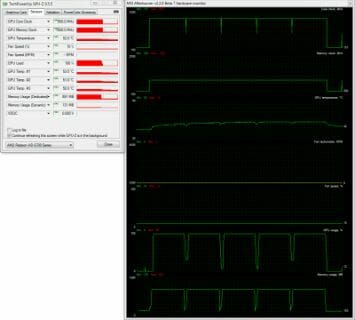Deepcool Dracula: Super Efficiency without Much Noise

We will talk about cooling efficiency and acoustic performance of the newest flagship VGA cooler from Deepcool Company.
Only a few months have passed since we tested a pretty successful V6000 graphics card cooler from Deepcool Industries Co., Ltd. And today they are already continuing their invasion into the VGA cooler market by launching the new product called Dracula. At the same time there also appears its clone, Alpenfoehn Peter with identical design and same characteristics. We are not going to try finding out which one of them is the original one (as they are most likely branded for different markets). Instead, we will take a real close look at the new Deepcool Dracula and its performance, especially since the 250 W heat dissipation promised in the official cooler specifications, look very promising. Let’s see if this is indeed the case.
Packaging and Accessories
Since we received the preproduction sample of the new Deepcool Dracula cooler, it arrived in a plain white cardboard packaging. However, we have a few images provided by the manufacturer at our disposal. Here is what its official packaging looks like:
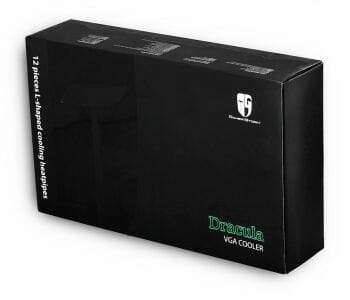
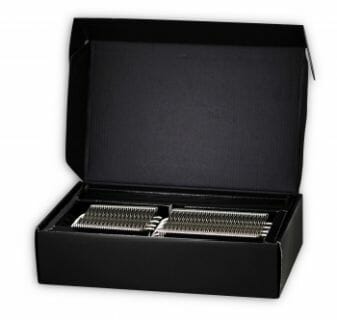
I would like to add that the packaging that our Dracula sample arrived in was very sturdy and could undoubtedly protect the cooler and the fans against many possible transportation mishaps.
Besides the heatsink and the fans, the accessories bundled with the cooler included the following items:
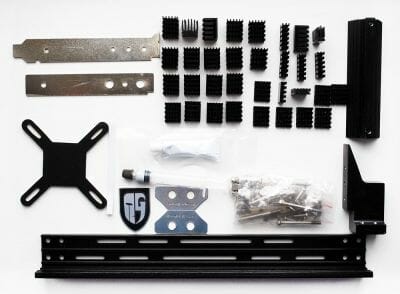
- Retention bracket and backplate for the system case back panel;
- 18 tall aluminum heatsinks for the video memory chips;
- 9 low-profile aluminum heatsinks for video memory chips;
- 6 narrow aluminum heatsinks for graphics card VRM components;
- A heatsink for AMD Radeon HD 6970/HD 6950 VRM;
- Steel backplate with insulating padding;
- Deepcool thermal paste;
- Thermal glue for the heatsinks;
- Two retention pads for the fans;
- Deepcool sticker;
- A set of retention screws, washers and screw-nuts and a special wrench for them;
- Fan retention frame;
- A mounting triangle or the fan frame;
- Installation manual.
The following chart will help sort out all the Dracula accessories in logical order:
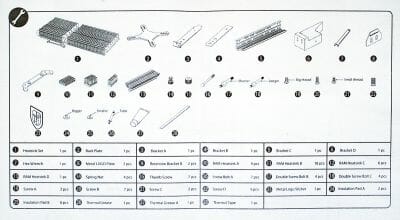
The cooler is manufactured in China. Its recommended retail price is $74.99 and it comes with 2-year warranty.
Design and Functionality
Frankly speaking, there is nothing extraordinary about the design of the Deepcool Dracula cooler. It consists of six copper heatpipes going through the copper base and piercing two independent heatsink fin arrays:
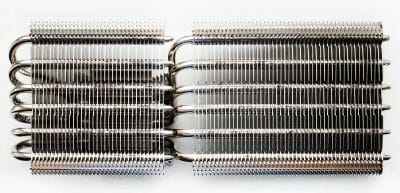
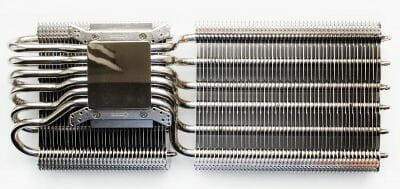
There is an additional low-profile heatsink installed right above the cooler base. All parts of the Dracula heatsink are nickel-plated.
The heatsink arrays are not of the same size: the smaller one has 31 fins and the larger one – 53 fins. Each aluminum fin is 0.45 mm thick and the gaps between them measure 2.0 mm:
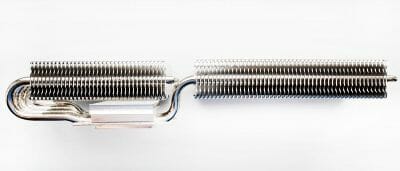
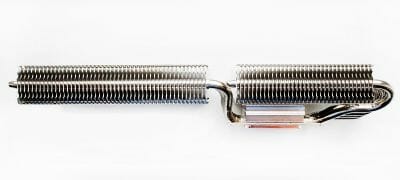
The entire heatsink measures 254x100x44 mm. Please, consult the layout below for more detailed dimensions:
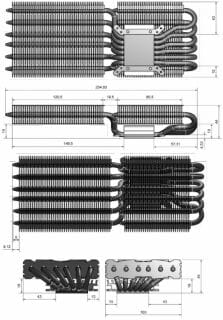
The heatsink weighs 555 grams, which is not too much, according to contemporary standards.
The heatpipes pierce Deepcool Dracula heatsink almost evenly at 9-11 mm intervals:
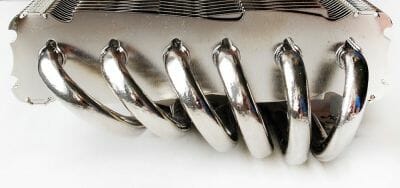
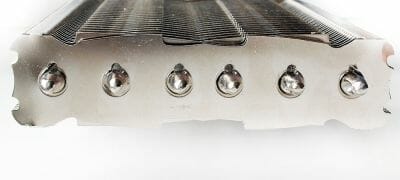
I have to point out that they used soldering in all contact spots between the heatpipes and the heatsink fins as well as heatpipes and cooler base. The entire structure is very stable and sturdy. The heatsink fins have a variable-height profile where the airflow enters and exits the heatsink body. It allows reducing not only the airflow resistance, but also the generated noise.
The heatpipes are spaced at 1.5 mm distance from one another in the base of the cooler:
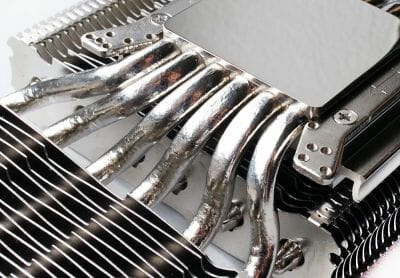
The contact surface of the Dracula base plate is not only ideally even, but is also remarkably finished:

As a result, Nvidia GF110 (GeForce GTX 580) produced a perfectly even imprint on the base of the cooler even with the smallest amount of thermal paste applied to the GPU heat-spreader:
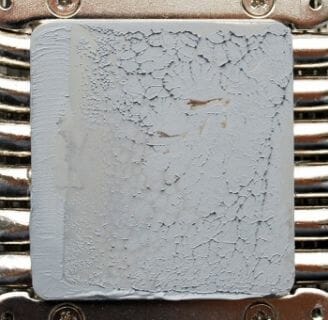
Deepcool Dracula is equipped with two 120 mm fans, which are very similar to Deepcool UF120, but feature unique teal impeller and a shiny silver sticker on the rotor:
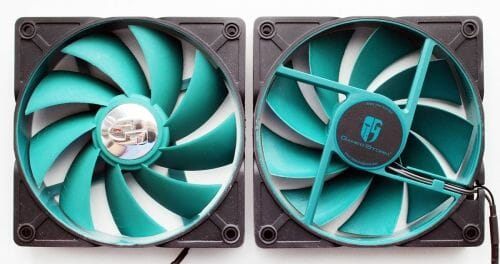
Unfortunately, so far we haven’t found the detailed specifications for these fans, but our measurements showed that their maximum rotation speed was 1230 RPM, startup voltage – 6.1 V, and maximum power consumption of each individual fan didn’t exceed 2.3 W. These fans do not allow adjusting their rotation speed using pulse-width modulation approach, and Deepcool didn’t offer any other ways of controlling their rotation speed. Unfortunately, the Y-splitter is also missing, so you won’t be able to connect both of them to a single 3-pin fan connector. We hope that these are temporary issues typical of our specific pr-production sample and they will be eliminated in the mass production units. The last thing I would like to add is that the fans come with 500 mm long cables.
Compatibility and Installation
Deepcool Dracula installation is very simple, so even if you don’t have the manual, you can install the heatsink onto the graphics card and the frame with fans into the system case intuitively. The detailed dimensions layout of the new Dracula cooler provided above will help you figure out whether it is compatible with your specific graphics accelerator or not. However, you can also refer to the following picture showing the distances between the retention holes:

As you can see, the numerous holes in the Dracula retention brackets make it practically fully universal, and the only thing that may limit its compatibility with graphics accelerators is the size.
To fasten the heatsink on the GPU you should use the enclosed threaded mounts (there are two different sets). These mounts should be inserted into the retention plates first:
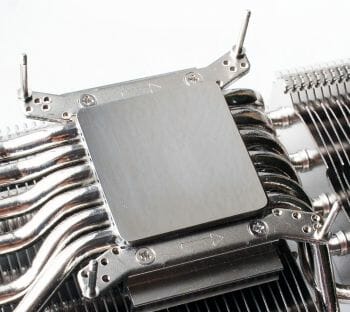
After that you should apply a layer of thermal paste onto the GPU surface, install the heatsink and secure it in place by tightening the screw-nuts on the bottom of the graphics card on top of the backplate:
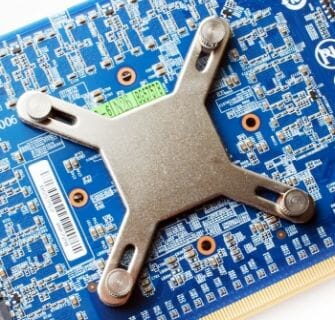
Even though the backplate pushes directly against the graphics card PCB, there is no need to worry about short circuiting, because there is a pretty thick insulating pad on the backplate. However, it would be nice to get a few additional bushes, which could prevent the backplate from sitting directly on the textolite and pushing against the electronic components on it.
This is what Deepcool Dracula looks like when it is installed onto GeForce GTX 580:
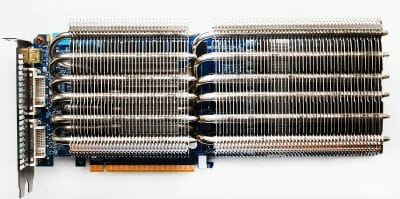
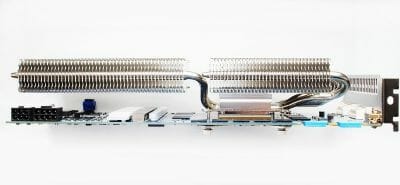
As we can see, Dracula heatsink doesn’t go beyond the PCB edges, which is very important. We would also like to point out that there is a 20 mm gap between the internal edge of the heatsink fins and the PCB textolite, which is more than enough to fit compact heatsinks onto the VRM and video memory chips. During our test session we didn’t stick the heatsinks onto the memory chips. As for the VRM components, they were already covered with an aluminum heatsink with sufficient cooling efficiency.
After that we install the graphics card into the mainboard slot and this is when the most interesting things start happening. You should install the stand for the fan frame into the slot next to the graphics card:
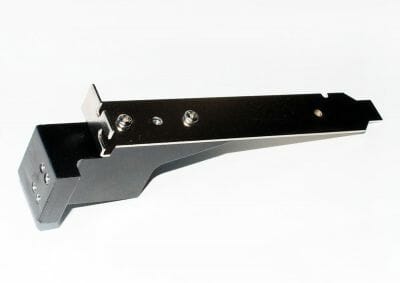
This frame will be attached not only with one screw at the top, but also with a retention plate to the back of the system case:
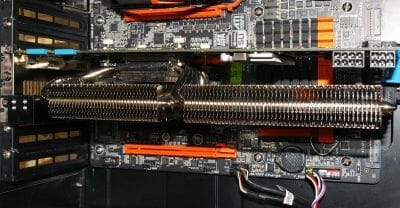
After that you can use a pair of screws and screw-nuts to fasten two Deepcool fans to the long metal bracket:
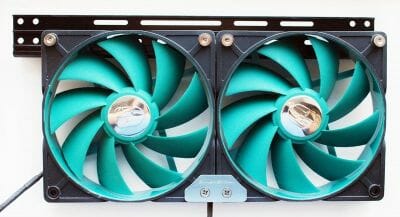
The slits in this bracket allow moving the fans along the steel plate. For additional sturdiness you can use metal pads with self-tapping screws to hold the bottom of the fan in place.
After that simply attach the frame with the fans to the mounting stand.
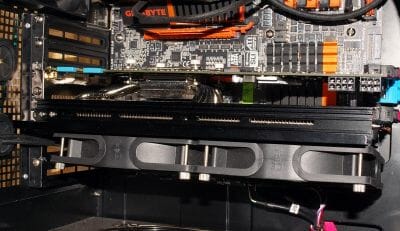
I can’t help mentioning that in a vertical system case the fans’ weight was still pulling them down a bit, despite the sturdy retention mechanism. Therefore, in order to avoid loss of efficiency because of the increased gap between the fan and the heatsink we recommend using some kind of support beneath the bottom edge of the fan frame, which will push against the PSU or the bottom of the system case. The only thing left to add at this point is that this entire structure will completely block all four PCI slots on the mainboard.
And that’s all. Dracula is all set and ready to go 🙂
Technical Specifications and Recommended Pricing
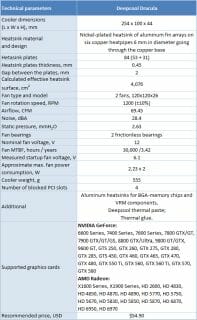
Testbed and Methods
The tests were performed in a closed system case. Our testbed was configured as follows:
- Mainboard: Gigabyte GA-X58A-OC (Intel X58 Express, LGA 1366, BIOS F5c from 9/6/2011);
- Processor: Intel Core i7-980X Extreme Edition, 3.33 GHz, 1.225 V, 6 x 256 KB L2, 12 MB L3 (Gulftown, B1);
- Thermal interface: ARCTIC MX-4;
- Memory: DDR3 3 x 2 GB OCZ Platinum Low-Voltage Triple Channel (Spec: 1600MHz / 7-7-7-24 / 1.65 V);
- Graphics card: Gigabyte GeForce GTX 580 1.5 GB Super Overclock, GDDR5, 384 bit, 855/1710/4100 MHz;
- System drive: RAID-0 of 2 x Kingston V-series SNV425S2128GB SSD (SATA-II, 128 GB, MLC, Toshiba TC58NCF618G3T controller);
- Drive for programs and games: Western Digital VelociRaptor (300GB, SATA-II, 10000 RPM, 16MB cache, NCQ) inside Scythe Quiet Drive 3.5” HDD silencer and cooler;
- Backup drive: Samsung Ecogreen F4 HD204UI (SATA-II, 2 TB, 5400 RPM, 32 MB, NCQ);
- System case: Antec Twelve Hundred (front panel: three Noiseblocker NB-Multiframe S-Series MF12-S2 fans at 1020 RPM; back panel: two Noiseblocker NB-BlackSilent PRO PL-1 fans at 1020 RPM; top panel: standard 200 mm fan at 400 RPM);
- Control and monitoring panel: Zalman ZM-MFC2;
- Power supply: Xigmatek “No Rules Power” NRP-HC1501 1500 W (with a default 140 mm fan).
I am sure you have already read our recent review of the Gigabyte graphics card equipped with a unique and pretty efficient cooling system:
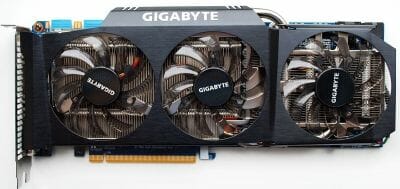
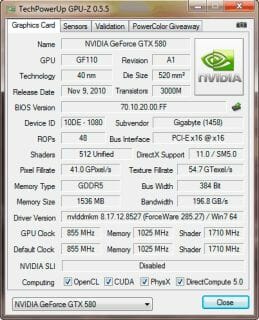
Deepcool Dracula is going to compete against this particular cooler.
The testing programs were installed under Microsoft Windows 7 Ultimate x64 SP1. We used DirectX End-User Runtimes libraries (from November 2010), Nvidia GeForce/ION 285.27 beta graphics card drivers. We used five runs of Aliens vs. Predator game in 2560×1600 resolution and with maximum image quality settings, 16x anisotropic filtering and 4x antialiasing:
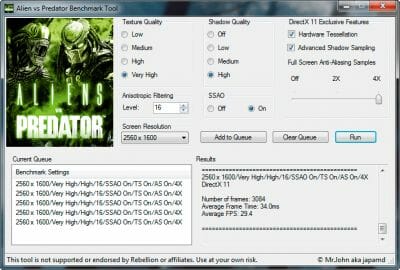
With the settings we used this test loads the powerful graphics accelerator very heavily, but can’t damage it, which could be the case with FurMark (this time we decided not to use this benchmark in our test session).
We used MSI Afterburner utility version 2.2.0 Beta 7 to monitor graphics card temperatures and frequencies and GPU-Z version 0.5.5 utility:
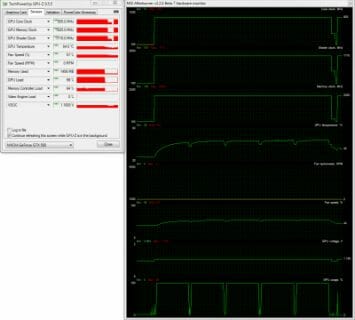
The tests were run at least twice. The temperature stabilization period between the two test cycles was about 10-12 minutes. The ambient temperature was checked next to the system case with an electronic thermometer with 0.1°C precision that allows monitoring the temperature changes over the past 6 hours. During our test session room temperature stayed around 22.4-22.6°C.
We used our in-house controller to adjust the rotation speed of the Deepcool fans.
The noise level of each cooler was measured between 1:00 and 3:00 AM in a closed room about 20 m2 big using CENTER-321 electronic noise meter. The noise level for each cooler was tested outside the system case when the only noise sources in the lab were the cooler and its fan. The noise meter was installed on a tripod and was always at a 150 mm distance from the cooler fan rotor. The tested cooling systems were placed at the edge of the desk on a sheet of polyurethane foam. The lowest noise reading our noise meter device can register is 29.8 dBA and the subjectively comfortable noise level in these testing conditions was around 36 dBA (do not mix it up with low noise level).
Performance
Cooling Efficiency Tests
The diagram below shows the results obtained during cooling-efficiency tests:
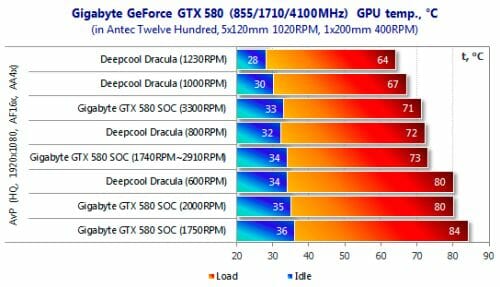
We have recently been impressed by the superb cooling efficiency demonstrated by Gigabyte’s WindForce 3X system, but today we see that Dracula didn’t leave it a single chance: the new Deepcool product outperformed the competitor in all speed modes. I would like to specifically point out the temperatures of the overclocked GeForce GTX 580 with Dracula cooling fans running at 600 RPM: it never exceeded 80 degrees C! I believe there is no need to tell you that at this speed you absolutely can’t hear the fans, so they are in fact completely silent against the background noises from the rest of the system case. Dracula I also quite acoustically comfortable at 1000 RPM: here the advantage over triple-fan Gigabyte cooler working at its maximum speed reaches 4°C, but it doesn’t really matter if you take into account the difference in noise, which we are going to discuss in just a little bit.
Unfortunately, Gigabyte GeForce GTX 580 1.5 GB Super Overclock doesn’t allow monitoring the temperatures of its VRM components, so it is hard to tell how well the new Deepcool Dracula copes with their cooling. However, since the graphics card remained perfectly stable at increased clock speeds for a minimum of 30-35 minutes, we could, probably, say with certainty, that the cooler does its job well indeed. Moreover, I would also like to add that we had to give up our initial intention to also test Deepcool Dracula on Sapphire Radeon HD 6950 2 GB Toxic Edition, because the heatsink enclosed with the Dracula cooler turned out incompatible with the second revision of the reference Radeon HD 6950, which is the one Sapphire used for their product. But I believe the tests we performed using overclocked GeForce GTX 580 give us a good idea of what the newcomer is capable of.
Noise Tests
The graph below shows the results of our noise tests performed for Deepcool Dracula and the default cooler on Gigabyte GeForce GTX 580 1.5 GB Super Overclock graphics card:

The difference in the level of noise generated by these two coolers is simply enormous. Up until 1000 RPM two 120 mm Deepcool fans do not add anything to the acoustic performance of the quiet system case, while the three 92 mm Gigabyte WindForce 3X fans can only be that quiet up to 1550 RPM – the speed, which the graphics card never hits even when idling in 2D mode. Even from a purely subjective standpoint we can say that Deepcool fans are awesome – they work smoothly and silently, without any vibrations, crackling or other parasitic sounds.
Conclusion
The new Deepcool Dracula cooler is an ideal product for those owners of single-GPU High-End graphics accelerators, who value not only efficient cooling, but also low-noise operation and are eager to sacrifice four PCI slots on their mainboard for the sake of that. Deepcool’s excellent Dracula cooler will meet the needs of those for $75. As for the drawbacks, we could mention that the VRM heatsink is incompatible with the second revision of the reference AMD Radeon HD 6970 and HD 6950 graphics cards and lacks a fan rotation speed variator, PWM-control support or at least a Y-splitter among the bundled accessories. Other than that, the cooler is simply impeccable, and besides superb cooling efficiency in fan-on mode, can also cope easily with such products as Radeon HD 6770 without any fans attached. Take a look:
